California Permit Test
5.0(3)
Card Sorting
1/156
Earn XP
Description and Tags
Study Analytics
Name | Mastery | Learn | Test | Matching | Spaced |
|---|
No study sessions yet.
157 Terms
1
New cards
Nearly _______ of the drivers between
15-19 years old are convicted of a
traffic violation in their first year of
driving.
15-19 years old are convicted of a
traffic violation in their first year of
driving.
50%
2
New cards
The most common violation is for
__________, which often results in the
loss of vehicle control and accounts
for about 50% of all teen traffic
convictions.
__________, which often results in the
loss of vehicle control and accounts
for about 50% of all teen traffic
convictions.
speeding
3
New cards
__________ are the leading
cause of death for teenagers
cause of death for teenagers
traffic collisions
4
New cards
If you
are under 18 years old, your risk of a
fatal collision is about _____ times that
of the "average" driver
are under 18 years old, your risk of a
fatal collision is about _____ times that
of the "average" driver
2 1/2
5
New cards
When you move, you must give
DMV your new address within ____
days.
DMV your new address within ____
days.
10
6
New cards
Children who are ______ years old or
older OR who have reached at least
_______ in height may use a properly
secured safety belt meeting federal
standards
older OR who have reached at least
_______ in height may use a properly
secured safety belt meeting federal
standards
1) 8
2) 4'9"
2) 4'9"
7
New cards
An air bag needs about ______ inches of
space to inflate. Ride at least ____ inches
(measured from the center of the
steering wheel to your breastbone)
from the air bag cover, if you can do
this while maintaining full control of
the vehicle.
space to inflate. Ride at least ____ inches
(measured from the center of the
steering wheel to your breastbone)
from the air bag cover, if you can do
this while maintaining full control of
the vehicle.
1) 10
2) 10
2) 10
8
New cards
It is illegal to leave a child ____ years
old or younger unattended in a motor
vehicle.
old or younger unattended in a motor
vehicle.
6
9
New cards
A child under six years of age can be left alone in a car under the supervision of a person _____ years
old or older.
old or older.
12
10
New cards
Solid Red
A red traffic signal light means "STOP." You can make a right turn against a red traffic signal light after you
stop. Yield to pedestrians, bicyclists, and vehicles close enough to be a hazard. Make the right turn only when it is safe. Do not turn if a "NO TURN ON RED" sign is posted.
stop. Yield to pedestrians, bicyclists, and vehicles close enough to be a hazard. Make the right turn only when it is safe. Do not turn if a "NO TURN ON RED" sign is posted.
11
New cards
Red Arrow
A red arrow means "STOP." Remain stopped until the green signal or green arrow appears. Do not turn against a red arrow.
12
New cards
Flashing Red
A flashing red traffic signal light means "STOP." After stopping, you may proceed when it is safe. Observe the right-of-way rules
13
New cards
Flashing Yellow
A flashing yellow traffic signal light warns you to "PROCEED WITH CAUTION." Slow down and be alert before entering the intersection. Yield to any pedestrians, bicyclists, or vehicles in the intersection. You do not need to stop for a flashing yellow traffic signal light
14
New cards
Flashing Yellow Arrow
This traffic signal light means turns are permitted
(unprotected), but you must first yield to oncoming traffic and pedestrians and then proceed with caution.
(unprotected), but you must first yield to oncoming traffic and pedestrians and then proceed with caution.
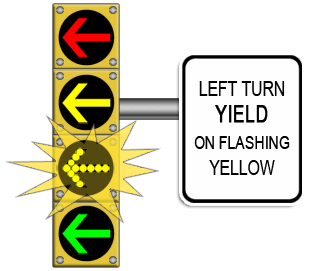
15
New cards
Traffic Signal Light Not Working
(Blackout)
(Blackout)
The traffic signal light is not working and/or no lights
are showing on the signal. Proceed cautiously as if the intersection is controlled by "STOP" signs in all directions.
are showing on the signal. Proceed cautiously as if the intersection is controlled by "STOP" signs in all directions.
16
New cards
3-sided red YIELD
sign
sign
indicates that you must slow down and be
ready to stop, if necessary, to let any vehicle, bicyclist, or pedestrian pass before you proceed.
ready to stop, if necessary, to let any vehicle, bicyclist, or pedestrian pass before you proceed.
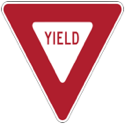
17
New cards
If you see WRONG WAY or DO NOT ENTER sign,
drive to the side of the road and stop. You are going against traffic. When safe, back out or turn around and return to the road you were on.
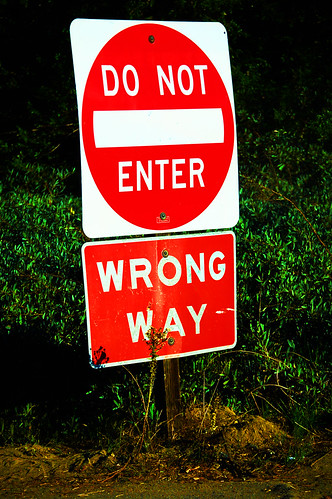
18
New cards
A yellow and black circular sign
indicates that you are approaching a railroad crossing

19
New cards
An x-shaped sign with a white background that
states RAILROAD CROSSING
states RAILROAD CROSSING
you must look, listen, slow down, and prepare to stop, if necessary. Let any trains pass before you proceed
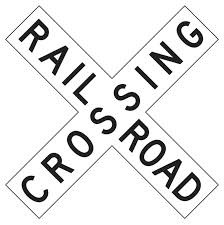
20
New cards
5-sided sign
indicates that you are near a school. Stop if children
are in the crosswalk.
are in the crosswalk.
21
New cards
4-sided diamond-shaped sign
warns you of specific road conditions and dangers ahead.
22
New cards
slippery when wet
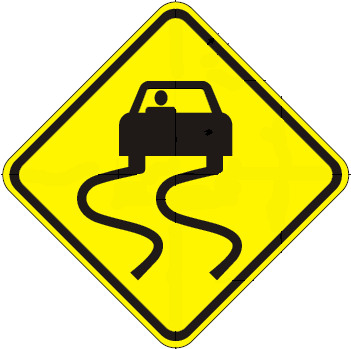
23
New cards
merging traffic
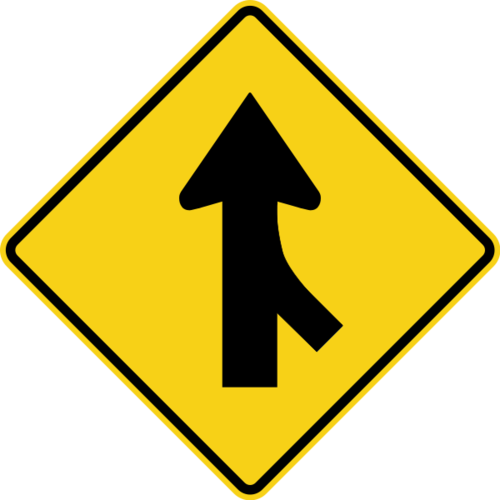
24
New cards
divided highway
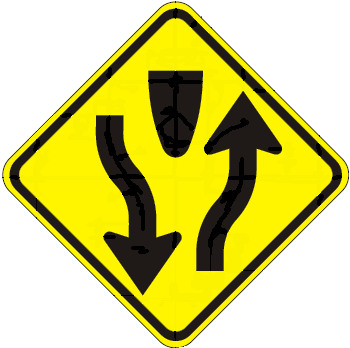
25
New cards
sharp turn
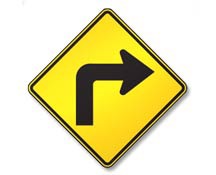
26
New cards
two way traffic
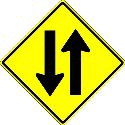
27
New cards
lane ends
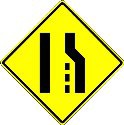
28
New cards
end divided highway
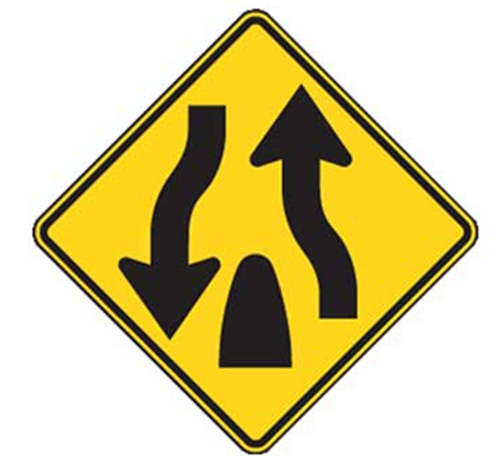
29
New cards
traffic signal ahead
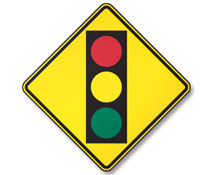
30
New cards
pedestrian crossing
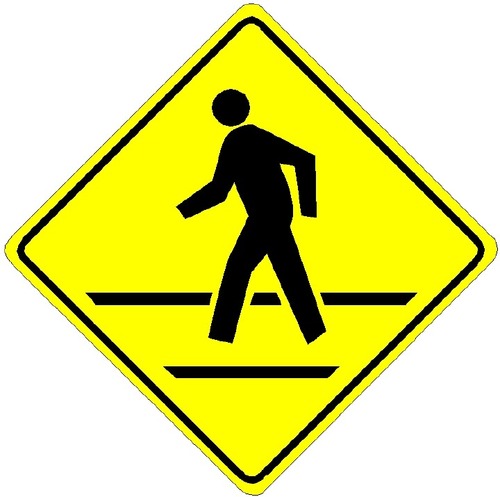
31
New cards
added lane
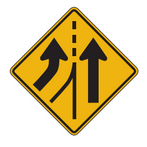
32
New cards
crossroad
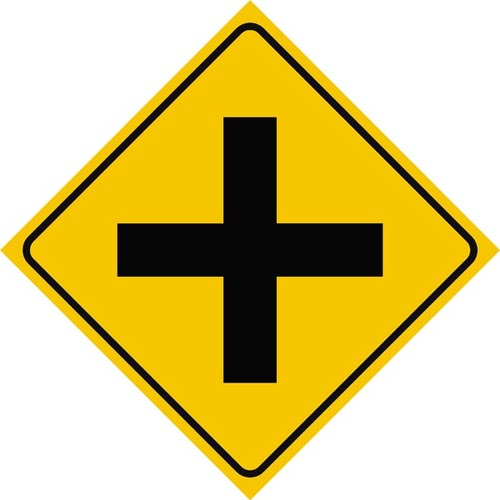
33
New cards
stop ahead

34
New cards
yield ahead

35
New cards
directional arrow

36
New cards
curve
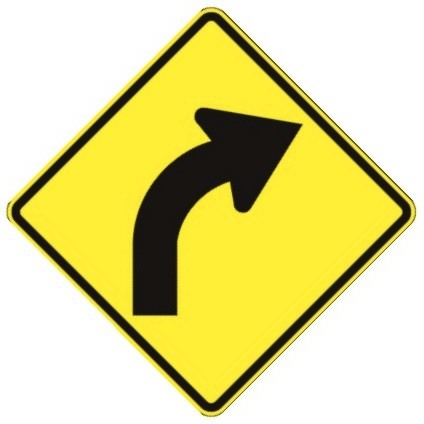
37
New cards
"T" intersection

38
New cards
winding road

39
New cards
In California, pedestrian deaths occur
in approximately ____ of all
traffic fatalities.
in approximately ____ of all
traffic fatalities.
22%
40
New cards
Do not drive on a sidewalk except
to cross it to enter or exit a driveway or alley. When crossing, yield to all pedestrians.
41
New cards
e. It is important that you stop your
vehicle within _______ of the crosswalk.
vehicle within _______ of the crosswalk.
5 feet
42
New cards
Pedestrians have the right-of-way
in marked AND unmarked crosswalks
43
New cards
At intersections without "STOP" or "YIELD" signs,
slow down and be ready to stop. Yield to traffic and pedestrians already in the intersection or just entering the intersection. Also, yield to the vehicle or bicycle that arrives first, or to the vehicle or bicycle on your right if it reaches the intersection at the same time as you.
44
New cards
At "T" intersections without "STOP" or "YIELD" signs,
yield to traffic and pedestrians on the through road. They have the right-of-way.
45
New cards
While waiting to turn left, keep your wheels pointed
straight ahead until it is safe to start turn
46
New cards
When you turn right,
be sure to check for pedestrians who want to cross the street and bicyclists riding next to you.
47
New cards
On divided highways or highways with several lanes
watch for vehicles coming in any lane you cross. Turn either left or right only when it is safe.
48
New cards
If you have parked on the side of the road or are leaving a parking lot, etc.,
yield to traffic before reentering the road.
49
New cards
When 2 vehicles meet on a steep mountain road where neither vehicle can pass,
the vehicle facing downhill must yield the right-of-way by backing up until the vehicle going uphill can pass. The vehicle facing downhill has the greater amount of control when backing up the hill.
50
New cards
The maximum speed limit on most California highways is
65 mph , can drive 70 mph when posted
51
New cards
Unless otherwise posted, the maximum speed limit on a two-lane undivided highway and for vehicles towing trailers is
55 mph
52
New cards
When you tow a vehicle or trailer, or drive a bus or 3 or more axle truck, you must drive in
the right most lane or in a lane specially marked for slower vehicles. If no lanes are marked and there are four lanes or more in your direction, you may only drive in either of the two lanes closest to the right edge of the road.
53
New cards
When driving within 500 to 1,000 feet of a school while children are outside or crossing the street, the speed limit is
25 mph unless otherwise posted
54
New cards
When the school bus flashes red lights (located at the
top front and back of the bus), you must
top front and back of the bus), you must
stop from either direction until the children are safely across the street and the lights stop flashing. The law requires you remain stopped as long as the red lights
are flashing
are flashing
55
New cards
The speed limit for a blind intersection is
15 mph
56
New cards
The speed limit in any alley is
15 mph
57
New cards
The speed limit is _____ within 100
feet of a railroad crossing where you
cannot see the tracks for 400 feet in
both directions.
feet of a railroad crossing where you
cannot see the tracks for 400 feet in
both directions.
15 mph
58
New cards
Stop at least ____ , but no more than ______, from the nearest track when the crossing devices are active or
a person warns you a train is coming.
a person warns you a train is coming.
1) 15
2) 50
2) 50
59
New cards
Business or Residential Districts
The speed limit is _______, unless
otherwise posted
The speed limit is _______, unless
otherwise posted
25 mph
60
New cards
Near Streetcars, Trolleys, or Buses
The passing speed limit, when safe
to pass, is no more than _____.
The passing speed limit, when safe
to pass, is no more than _____.
10 mph
61
New cards
If you see animals or livestock near the roadway
slow down and proceed with caution
62
New cards
Before changing lanes,
look into your rear view mirror for nearby vehicles and over your shoulder to check for blind spots.
63
New cards
Turn on your lights during the day if
it is hard to see or you cannot see at least
1,000 feet ahead of you.
1,000 feet ahead of you.
64
New cards
Solid yellow lines
mark the center of a road used for two-way traffic. No passing if the solid yellow line is on your side.
65
New cards
Broken yellow lines
indicate that you may pass if the broken line is next to your driving lane.
66
New cards
Two solid yellow lines
indicate no passing.
67
New cards
You may turn left across a single set of double yellow lines to
enter or exit a driveway, make a U-turn, or into or out of a private road.
68
New cards
Two sets of solid double yellow lines spaced 2 feet or more apart
are considered a barrier. Do not drive on or over this barrier, make a left turn, or a U-turn across it, except at
designated openings
designated openings
69
New cards
Solid white lines
mark traffic lanes going in the same direction, such as
one-way streets.
one-way streets.
70
New cards
Broken white lines
separate traffic lanes on roads with two or more
lanes in the same direction.
lanes in the same direction.
71
New cards
Double white lines
two solid white lines that indicate a lane barrier
between a regular use and a preferential use lane, such as a carpool/HOV. Never change lanes while in these lanes; wait until a single broken white line appears
between a regular use and a preferential use lane, such as a carpool/HOV. Never change lanes while in these lanes; wait until a single broken white line appears
72
New cards
Pass traffic on the left. You may pass on the right only when
• An open highway is clearly marked for two or more lanes of travel in your direction.
• The driver ahead of you is turning left and you do not drive off the roadway to pass. Never pass on the left if the driver is signaling a left turn.
• The driver ahead of you is turning left and you do not drive off the roadway to pass. Never pass on the left if the driver is signaling a left turn.
73
New cards
If you are driving slowly on a two-lane highway or
road where passing is unsafe, and 5 or more vehicles are following you must
road where passing is unsafe, and 5 or more vehicles are following you must
drive into the turnout areas or lanes to let the vehicles pass
74
New cards
When you are making a right turn within 200 feet of the corner or other driveway entrance, you must enter
the bicycle lane only after
the bicycle lane only after
ensuring there is no bicycle traffic, and then make the turn. Do not drive in the bicycle lane at any other time.
75
New cards
Left turns
To make a left turn, drive close to the center divider line
or into the left turn lane. Begin signaling about 100 feet before the turn.
or into the left turn lane. Begin signaling about 100 feet before the turn.
76
New cards
A left turn against a red light can only be made
from a one-way street onto a one-way street
77
New cards
Never make a U-turn:
•At or on a railroad crossing.
•On a divided highway by crossing a dividing section, curb, strip of land, or two sets of double yellow
lines.
• Where you cannot see clearly 200 feet in each direction because of a curve, hill, rain, fog, or other
reason.
• Where a "No U-Turn" sign is posted.
•When other vehicles may hit you.
•On a one-way street.
•In front of a fire station. Never use a fire station driveway to turn your vehicle around.
•In business districts.
•On a divided highway by crossing a dividing section, curb, strip of land, or two sets of double yellow
lines.
• Where you cannot see clearly 200 feet in each direction because of a curve, hill, rain, fog, or other
reason.
• Where a "No U-Turn" sign is posted.
•When other vehicles may hit you.
•On a one-way street.
•In front of a fire station. Never use a fire station driveway to turn your vehicle around.
•In business districts.
78
New cards
When you park:
• On a sloping driveway,
• On a sloping driveway,
turn the wheels so the vehicle will not roll into the street if the brakes fail
79
New cards
When you park: Headed downhill
turn your front wheels into the curb or toward the
side of the road. Set the parking brake
side of the road. Set the parking brake
80
New cards
When you park: Headed uphill
turn your front wheels away from the curb and let
your vehicle roll back a few inches.
your vehicle roll back a few inches.
81
New cards
When you park: Headed either uphill or downhill
when there is no curb,
when there is no curb,
turn the wheels so the vehicle will roll away from the center of the road if the brakes fail.
82
New cards
Parking at Colored Curbs: White
Stop only long enough to pick up or drop off passengers or mail.
83
New cards
Parking at Colored Curbs: Green
Park for a limited time. Look for a posted sign next to the green zone for time limits, or locate the time limit painted on the curb
84
New cards
Parking at Colored Curbs: Yellow
Stop no longer than the time posted to load or unload passengers or freight. Drivers of noncommercial
vehicles are usually required to stay with the vehicle.
vehicles are usually required to stay with the vehicle.
85
New cards
Parking at Colored Curbs: Red
-No stopping, standing, or parking. (Buses may stop at a red zone marked for buses.
86
New cards
Parking at Colored Curbs: Blue
Parking is permitted only for a disabled person
or driver of a disabled person who displays a placard
or special license plate.
or driver of a disabled person who displays a placard
or special license plate.
87
New cards
When you park alongside a curb on a level street,
the front and back wheels must be parallel and within
18 inches of the curb. Park parallel to the street if there is no curb
18 inches of the curb. Park parallel to the street if there is no curb
88
New cards
Use Your Headlights
When it is cloudy, raining, snowing, or foggy. If weather conditions require you to use your windshield wipers, you are required to turn on your low-beam headlights—it's the law.
89
New cards
Do not _____ before merging into freeway traffic
STOP
90
New cards
Do not pass:
• If you are approaching a hill or curve and you cannot see if there is another vehicle approaching.
•Within 100 feet of an intersection
•Within 100 feet of an intersection
91
New cards
Large trucks take ______ to stop than vehicles traveling at the same speed.
longer
92
New cards
Emergency Vehicles
You must yield the right-of-way to any police vehicle, fire engine, ambulance, or other emergency vehicle
using a siren and red lights. Drive to the right edge of the road and stop until the emergency vehicle(s) have
passed. However, never stop in an intersection. If you are in an intersection when you see an emergency
vehicle, continue through the intersection and then, drive to the right as soon as it is safe and stop.
using a siren and red lights. Drive to the right edge of the road and stop until the emergency vehicle(s) have
passed. However, never stop in an intersection. If you are in an intersection when you see an emergency
vehicle, continue through the intersection and then, drive to the right as soon as it is safe and stop.
93
New cards
It is against the law to follow within _________ behind any fire engine, police vehicle, ambulance, or other
emergency vehicle with a siren or flashing lights
emergency vehicle with a siren or flashing lights
300 ft
94
New cards
A diamond-shaped sign on a truck
means that the load on the truck is potentially dangerous
95
New cards
If your vehicle starts to hydroplane,
slow down gradually—do not apply the brakes.
96
New cards
Wet road
go 5 to 10 mph slower.
97
New cards
Packed snow
reduce your speed
by half
by half
98
New cards
Ice
slow to a crawl.
99
New cards
Driving in the Fog
if you must drive, then drive slow, turn on your windshield wipers, and use your low-beam headlights. The light from the highbeam headlights will reflect back
and cause glare.
and cause glare.
100
New cards
Use your _______ headlights at
night when it rains
night when it rains
low beam